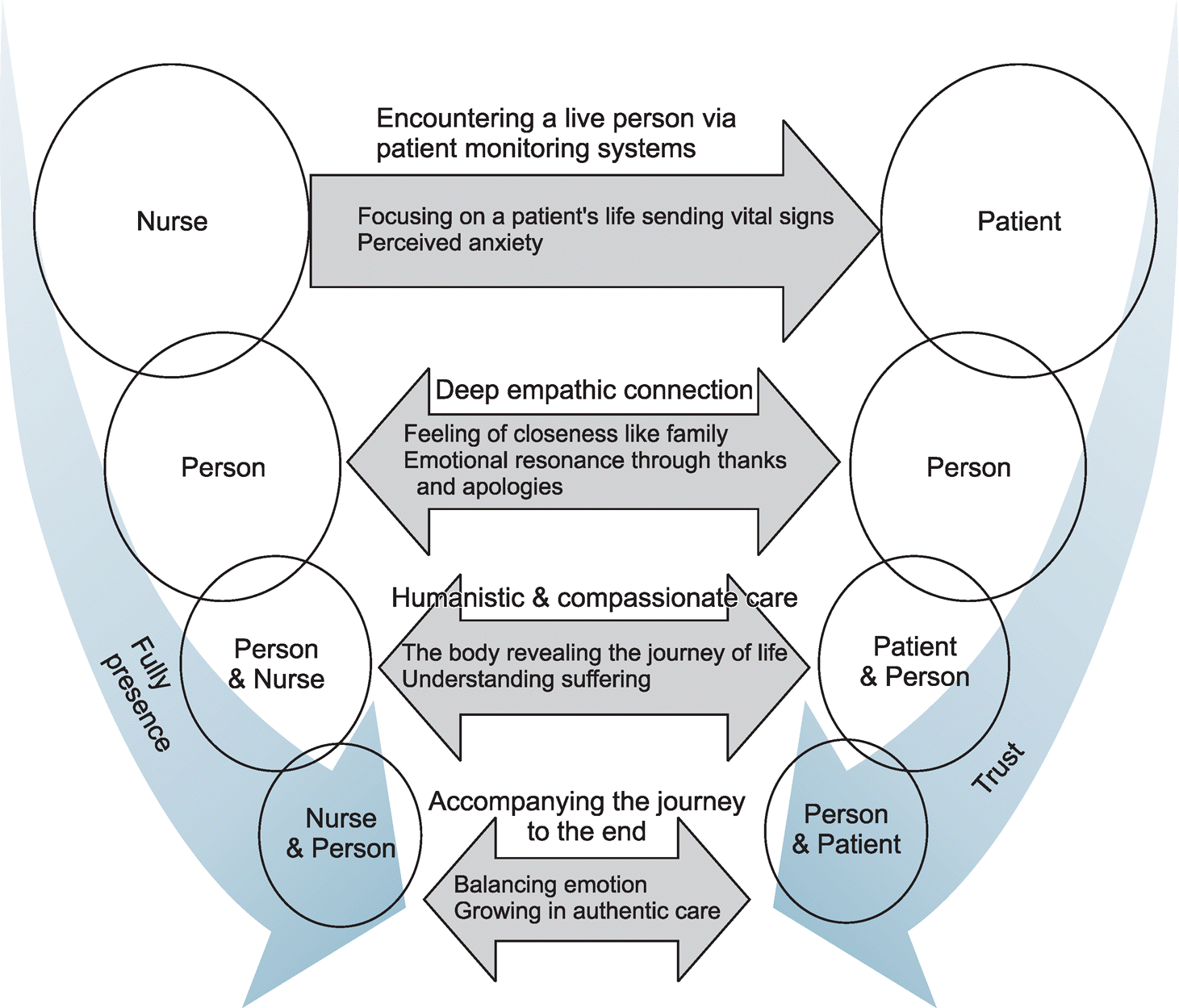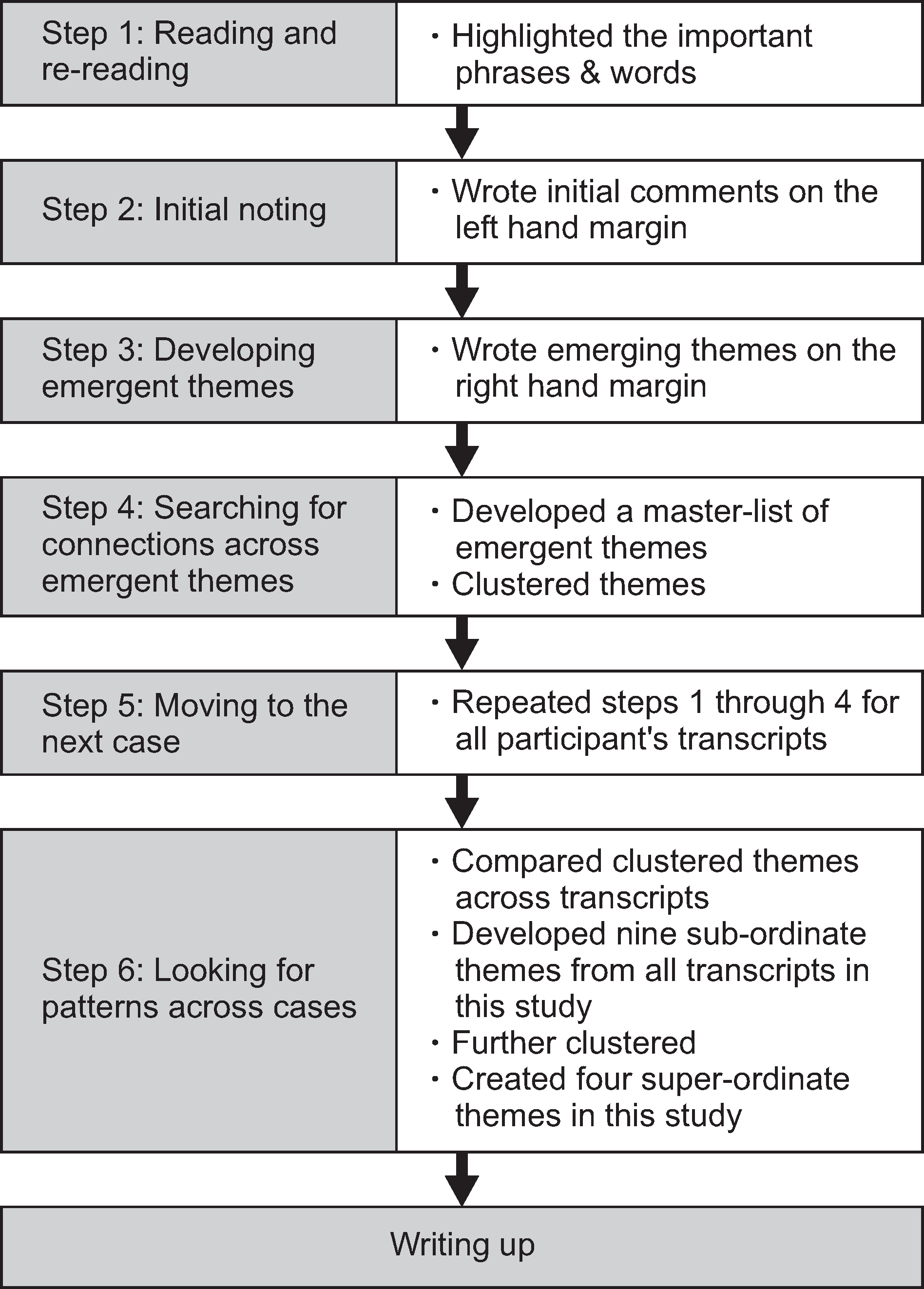Abstract
Purpose
The aim of the study was to explore nurses’ experience of person-centered relational care in the context of critical care.
Methods
Key interview questions were developed based on the human-to-human relationship model suggested by Travelbee. Data were collected through in-depth interviews with a purposive sample of 11 nurses having more than 2 years of working experience in intensive care units. An interpretative phenomenological analysis was conducted to analyze the data.
Results
Four super-ordinate and nine sub-ordinate themes were identified. Emerged super-ordinate themes were as follows: (1) encountering a live person via patient monitoring systems; (2) deep empathic connection; (3) humanistic and compassionate care, and (4) accompanying the journey to the end. Study findings revealed that nurses in intensive care units experienced ‘balancing emotions’ and ‘authenticity’ in caring when entering human-to-human relationships with dying patients. The phenomenon of person-centered relational care in intensive care units was found to subsume intrinsic attributes of empathy, compassion, and trust, similar to the central concepts of Travelbee's theory.
Conclusion
The interpretative findings in this study provide deeper understanding of Travelbee's human-to-human relationship model. The technological environment in intensive care units did not hinder experienced nurses from forming human-to-human relationships. These themes need to be emphasized in critical care nursing education as well as in nursing management. The results of this study will contribute to understanding nurse-patient caring relationships in depth, and help improve the quality of nursing care in intensive care units.
Go to : 
References
1. Watson J. Nursing: Human science and human care: A theory of nursing. Sudbury (MA): Jones & Bartlett Publishers;1999. p. 1–111.
2. Drahošová L, Jarošová D. Concept caring in nursing. Central European Journal of Nursing and Midwifery. 2016; 7(2):453–460. https://doi.org/10.15452/CEJNM.2016.07.0014.

3. O’Connell E. Therapeutic relationships in critical care nursing: A reflection on practice. Nursing in Critical Care. 2008; 13(3):138–143. https://doi.org/10.1111/j.1478-5153.2008.00273.x.

4. Bridges J, Nicholson C, Maben J, Pope C, Flatley M, Wilkinson C, et al. Capacity for care: Meta‐ethnography of acute care nurses’ experiences of the nurse‐patient relationship. Journal of Advanced Nursing. 2013; 69(4):760–772. https://doi.org/10.1111/jan.12050.

5. Happ MB, Garrett K, Thomas DD, Tate J, George E, Hou-ze M, et al. Nurse-patient communication interactions in the intensive care unit. American Journal of Critical Care. 2011; 20(2):e28–e40. https://doi.org/10.4037/ajcc2011433.

6. Wilkin K, Slevin E. The meaning of caring to nurses: An investigation into the nature of caring work in an intensive care unit. Journal of Clinical Nursing. 2004; 13(1):50–59. https://doi.org/10.1111/j.1365-2702.2004.00814.x.

7. Alasad J, Ahmad M. Communication with critically ill patients. Journal of Advanced Nursing. 2005; 50(4):356–362. https://doi.org/10.1111/j.1365-2648.2005.03400.x.

8. McGrath M. The challenges of caring in a technological environment: Critical care nurses’ experiences. Journal of Clinical Nursing. 2008; 17(8):1096–1104. https://doi.org/10.1111/j.1365-2702.2007.02050.x.

9. Elliott R, Wright L. Verbal communication: What do critical care nurses say to their unconscious or sedated patients? Journal of Advanced Nursing. 1999; 29(6):1412–1420. https://doi.org/10.1046/j.1365-2648.1999.01028.x.

10. Topçu S, Ecevit Alpar Ş, Gülseven B, Kebapçı A. Patient experiences in intensive care units: A systematic review. Patient Experience Journal. 2017; 4(3):115–127. https://doi.org/10.35680/2372-0247.1137.

11. Dinç L, Gastmans C. Trust in nurse-patient relationships: A literature review. Nursing Ethics. 2013; 20(5):501–516. https://doi.org/10.1177/0969733012468463.
12. Hinderer KA. Reactions to patient death: The lived experience of critical care nurses. Dimensions of Critical Care Nursing. 2012; 31(4):252–259. https://doi.org/10.1097/DCC.0b013e318256e0f1.
13. Price AM. Caring and technology in an intensive care unit: An ethnographic study. Nursing in Critical Care. 2013; 18(6):278–288. https://doi.org/10.1111/nicc.12032.

14. Kang HJ, Bang KS. Neonatal intensive care unit nurses’ experience in caring for infants who are dying. Child Health Nursing Research. 2013; 19(4):252–261. https://doi.org/10.4094/chnr.2013.19.4.252.

15. Seol EM, Koh CK. Experiences of critical care nurses caring for dying patients. Journal of Korean Critical Care Nursing. 2018; 11(2):1–10.
16. Yi M. Nurses’ experience of caring for dying patients in hospitals. Journal of Korean Academy of Nursing. 2003; 33(5):553–561. https://doi.org/10.4040/jkan.2003.33.5.553.

18. Travelbee J. What’s wrong with sympathy? The American Journal of Nursing. 1964; 64:68–71. https://doi.org/10.2307/3452776.

19. Travelbee J. Interpersonal aspects of nursing. 2nd ed. Philadelphia (PA): F.A. Davis Company;1971. p. 1–242.
20. Smith JA, Flowers P, Larkin M. Interpretative phenomenological analysis: Theory, method and research. London: SAGE Publications;2009. p. 1–217.
21. Pringle J, Drummond J, McLafferty E, Hendry C. Interpretative phenomenological analysis: A discussion and critique. Nurse Researcher. 2011; 18(3):20–24. https://doi.org/10.7748/nr2011.04.18.3.20.c8459.

23. Yardley L. Dilemmas in qualitative health research. Psychology & Health. 2000; 15(2):215–228. https://doi.org/10.1080/08870440008400302.

24. Jakimowicz S, Perry L. A concept analysis of patient‐centred nursing in the intensive care unit. Journal of Advanced Nursing. 2015; 71(7):1499–1517. https://doi.org/10.1111/jan.12644.

25. Sinclair S, Beamer K, Hack TF, McClement S, Raffin Bouchal S, Chochinov HM, et al. Sympathy, empathy, and compassion: A grounded theory study of palliative care patients’ understandings, experiences, and preferences. Palliative Medicine. 2017; 31(5):437–447. https://doi.org/10.1177/0269216316663499.

26. Errasti-Ibarrondo B, Pérez M, Carrasco JM, Lama M, Zaragoza A, Arantzamendi M. Essential elements of the relationship between the nurse and the person with advanced and terminal cancer: A meta-ethnography. Nursing Outlook. 2015; 63(3):255–268. https://doi.org/10.1016/j.outlook.2014.12.001.
27. Hong S. A phenomenological study of the caring in nursing science. Research in Philosophy and Phenomenology. 2011; 50:213–241.
28. Engström Å, Söderberg S. Close relatives in intensive care from the perspective of critical care nurses. Journal of Clinical Nursing. 2007; 16(9):1651–1659. https://doi.org/10.1111/j.1365-2702.2005.01520.x.
30. Chen C, Chow AYM, Tang S. Bereavement process of profes- sional caregivers after deaths of their patients: A meta-ethnographic synthesis of qualitative studies and an integrated model. International Journal of Nursing Studies. 2018; 88:104–113. https://doi.org/10.1016/j.ijnurstu.2018.08.010.
Go to : 
 | Figure 2.Study findings of person-centered relational care experienced by intensive care unit nurses. |
Table 1.
Participant Characteristics
Table 2.
Key Interview Questions
Table 3.
List of Super-ordinate Themes, Sub-ordinate Themes, and Quotes




 PDF
PDF ePub
ePub Citation
Citation Print
Print



 XML Download
XML Download